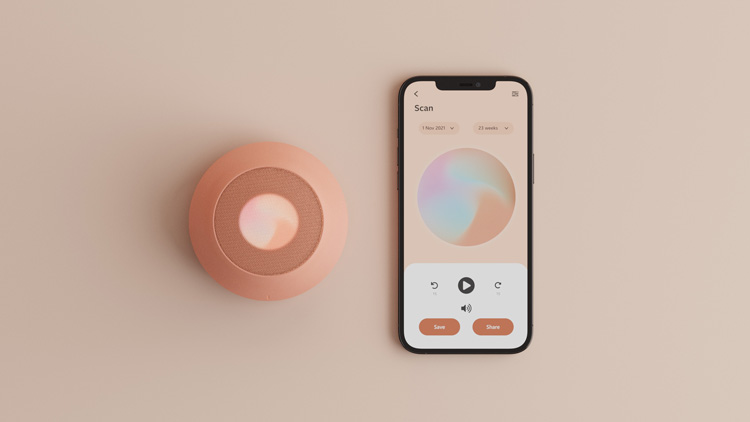These handheld products aim to better support parents through pregnancy
Developed by product design studio Morrama, the Prenatal Care concept project features three devices to help parents bond with unborn children.
The pandemic and subsequent lockdowns have proved particularly dangerous for babies. Research suggests the drain on health services resulted in a near four-fold increase in stillbirths at points in the pandemic – while other data reveals 20% rise in babies killed or harmed during the first lockdown of 2020.
These statistics and others like it were the driving force behind product design studio Morrama’s latest project – a series of device concepts which aim to support parent through pregnancy and help them develop positive relationships with their unborn children.

“We spent more time sitting, talking and reading”
The Prenatal Care range consists of three handheld products which have been developed with insights from maternity ward doctors, according to Morrama founder and CEO Jo Barnard.
Additional input has also been given from new and expecting mothers, so get an idea of “the challenges they faced, particularly those whose experience was during the COVID lockdowns,” she explains.
Given the statistics that inspired the project, it was a heavy experience at times. “We spent a lot more time sitting, talking and reading during this project than designing,” says Barnard. “Sharing our thoughts, feelings and ideas ensured we were approaching the design sensitively and as a result, we spent longer on this project than on previous conceptual explorations.”

Three devices
The first of the devices is a wearable which allows parents to track anomalies in the baby’s movements in the womb. A sensor is clipped to the waistband, and the resulting data is sent to a connected smartphone app. Monitoring of the data could help parents know “when to seek medical advice”, according to the studio. Additionally, it could provide a record for medical professionals.
Meanwhile another of the devices helps guide those in labour through hypno-birthing techniques. These exercises are a common practice encouraged by medical professionals to help manage the pain and stress of childbirth. When held in the hand, it can be rotated and squeezed and the resulting sharp sensation is supposed to distract from contractions.
The final of the devices is a scanner which amplifies the sounds of the baby in the womb. Again connected to an app, the recordings can be saved and shared. This feature is particularly useful for those unable to attend pregnancy appointments in person.

“Reassuring and approachable”
For each of the devices, the studio has ensured the technology is simple and effective to use. “Minimal, intuitive design was a crucial factor here,” Barnard explains. This is so parents would be able to use the devices and UX at home, without medical professional supervision.
“We sketched and modelled over 20 iterations of the designs in-house before we were happy with the forms,” she continues. This was then finished with an aesthetic that felt “reassuring and approachable”.

“Prenatal support and services are not good enough”
Currently the products are concepts. However Barnard says there is a very real need for products like these. “Pandemics are only going to become more prevalent,” she says. “This concept range highlights the need for accessible technology that expecting parents can use in the comfort of their homes.”
Looking to the future, the designer envisions the products being made available for rent via the NHS and private healthcare providers for the duration of a pregnancy. Until then, it is hoped the range can provoke meaningful conversations on how technology could support GPs and medical services to provide ongoing, high-quality care to pregnant people.
“Unfortunately, prenatal support and services are not good enough and we can, with a balance of thoughtful design and technology, not just improve the experience, but save lives,” Barnard says.

What do you think of the concept designs from Morrama? Let us know in the comments below…
-
Post a comment





